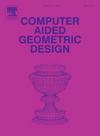Sibson高阶Voronoi图的公式
IF 1.7
4区 计算机科学
Q3 COMPUTER SCIENCE, SOFTWARE ENGINEERING
引用次数: 0
摘要
让年代是一组n个点通常在Rd位置。k阶泰森多边形法图的年代,Vk (S),是一个细分的Rd进入细胞的点相同的事务部门主管美国Sibson k最近的点在他的论文从1980年(狄利克雷镶嵌一个向量的身份),让一个公式来表达点Q的凸组合其他点的年代使用的比率卷V2的十字路口的细胞(S)和细胞问的V1 (S)。自然邻域插值法基于Sibson公式。我们利用任意阶的Voronoi图的体积比,推广了他的结果,将Q表示为S的其他点的凸组合。本文章由计算机程序翻译,如有差异,请以英文原文为准。
Sibson's formula for higher order Voronoi diagrams
Let S be a set of n points in general position in . The order-k Voronoi diagram of S, , is a subdivision of into cells whose points have the same k nearest points of S. Sibson, in his seminal paper from 1980 (A vector identity for the Dirichlet tessellation), gives a formula to express a point Q of S as a convex combination of other points of S using ratios of volumes of the intersection of cells of and the cell of Q in . The natural neighbour interpolation method is based on Sibson's formula. We generalize his result to express Q as a convex combination of other points of S by using ratios of volumes from Voronoi diagrams of any given order.
求助全文
通过发布文献求助,成功后即可免费获取论文全文。
去求助
来源期刊

Computer Aided Geometric Design
工程技术-计算机:软件工程
CiteScore
3.50
自引率
13.30%
发文量
57
审稿时长
60 days
期刊介绍:
The journal Computer Aided Geometric Design is for researchers, scholars, and software developers dealing with mathematical and computational methods for the description of geometric objects as they arise in areas ranging from CAD/CAM to robotics and scientific visualization. The journal publishes original research papers, survey papers and with quick editorial decisions short communications of at most 3 pages. The primary objects of interest are curves, surfaces, and volumes such as splines (NURBS), meshes, subdivision surfaces as well as algorithms to generate, analyze, and manipulate them. This journal will report on new developments in CAGD and its applications, including but not restricted to the following:
-Mathematical and Geometric Foundations-
Curve, Surface, and Volume generation-
CAGD applications in Numerical Analysis, Computational Geometry, Computer Graphics, or Computer Vision-
Industrial, medical, and scientific applications.
The aim is to collect and disseminate information on computer aided design in one journal. To provide the user community with methods and algorithms for representing curves and surfaces. To illustrate computer aided geometric design by means of interesting applications. To combine curve and surface methods with computer graphics. To explain scientific phenomena by means of computer graphics. To concentrate on the interaction between theory and application. To expose unsolved problems of the practice. To develop new methods in computer aided geometry.
 求助内容:
求助内容: 应助结果提醒方式:
应助结果提醒方式:


